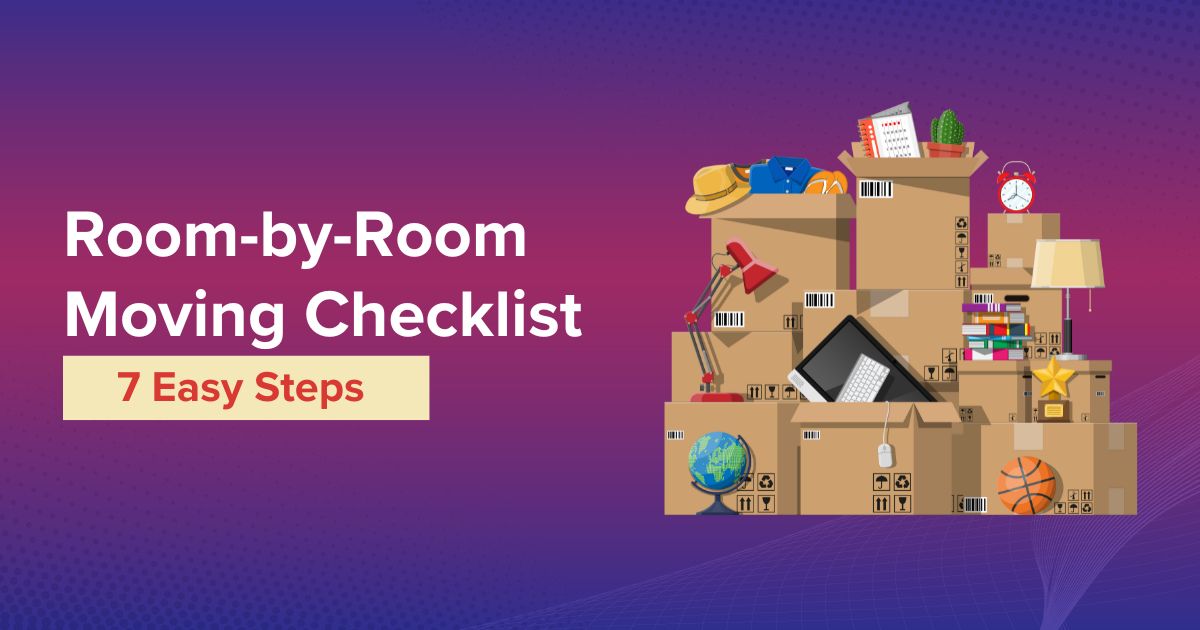A room-by-room moving checklist can serve multiple purposes when you move to a new home.
It can help you budget your packaging purchases, find items to declutter, and keep boxes organized from point A to point B, even if you hire professional movers.
Have you had a bad moving experience? A room-by-room moving checklist is your first step to a better move this time.
A room-by-room moving checklist is different from a general moving checklist, which usually outlines a timeline of events.
It’s also distinct from a moving budget, even though both can involve some level of inventory.
A room-by-room moving checklist does more than just list items; it helps you keep track of each box as it moves from one location to another.
This checklist can also be useful for the moving company, providing movers with specific instructions to ensure each box is placed in the correct room.
Here’s how to make an ultimate room-wise moving checklist to help you pack, organize, budget, and move.
7 Steps for a Room-by-Room Home Moving Checklist
This 7-step guide will help anyone create a comprehensive room-by-room moving checklist. By breaking this enormous task into manageable steps and organizing them according to each room in the home, you can make your checklist and tackle one room per day or whatever is most convenient for you.
1. Start Early and Gather Supplies
Begin making your moving checklist as soon as you know you’re moving to allow time to assess each room and itemize your belongings thoroughly.
You will likely want to keep your moving checklist as a digital sheet, whether you use Microsoft Excel, Google Sheets, or an inventory app like Home Contents.
Therefore, you will need your phone or tablet charged. A portable device will allow you to move from room to room as you take stock of your stuff.
Paper and a pen are quaint and portable, but this will be a long list to manage in handwriting, especially if you need to erase and edit items. A digital spreadsheet or app is easy to amend in seconds.
Gather essential supplies such as:
- Notepads ($1.25 at Dollar Tree)
- Pens ($0.19/each on Amazon)
- Markers ($0.61/each on ForMyDesk)
- Color-coded Labels ($5.99 on Amazon)
- Measuring Tape ($1.19 at Walmart)
These tools will help you categorize, organize, and label the items on your checklist and the boxes they go into.
2. Make a Checklist Outline for Each Room
Make a list of all the rooms in your current home, including common areas like the living room, kitchen, bedrooms, bathrooms, home office, dining room, garage, shed, closets, and attic.
If you use a physical notebook, create a separate section for each room.
If you use a Google spreadsheet or Excel, add a new tab for each room. If you use an app, most of them automatically help you create separate lists according to different rooms or areas.
Add a column or tag for each room that indicates items meant for sale, donation, or giving away (and to whom). You do not need to tag the items moving with you; that’s a given.
3. List the Largest Items in Each Room
It’s time to start listing items in each room. Later in this article, we’ll give you the lists of everyday items found in each room in American homes.
For now, here is the order in which we suggest tackling the rooms while listing the major stuff.
- Start with the kitchen and list significant items such as dishes, pots, pans, cutlery, appliances, and cookbooks. List everything and mark items that will be donated, sold, or given away.
- Make a sub-list of essential items you’ll want to unpack first so you can eat when you reach your new home. These items include bottled water, basic utensils, knives, and simple condiments.
- Move to the living room and make a list of all the furniture, electronics, lighting fixtures, and decor items there. Again, note the items that will be disposed of before you move.
- Continue with bathrooms, bedrooms, home office, dining room, garage, shed, closets, and attic, listing relevant items specific to each area.
- Don’t forget large appliances, like the washer and dryer, if they are coming with you to your next home.
4. Add Subcategories and Quantities
Within each room section, create subcategories to organize your checklist further. For example, under the kitchen, you can have subcategories like dishes, cookware, appliances, and pantry items.
Include details such as quantities, sizes, and descriptions for each item. In an app, there is space for item notes. On a spreadsheet, you can use different columns for each data point.
As expert movers, we appreciate any moving day hack that tells us what is inside each box. These clues tell us how to handle the box and where to put it once we reach the destination.
5. Add Packaging Details
Do you have items that require special packing services? If you are using an app, add the packaging details in a separate column on your spreadsheet or in the notes section of each item.
These details will help you keep track of the packaging you’ll need to cover every item, such as how many mattress covers you may need or how much bubble wrap you’ll use in the dining room.
6. Review and Update Regularly
Review and check items on your room-by-room moving checklist as you pack them. You can adjust the list of things to be moved as needed as you acquire them and declutter them before moving day.
7. Finalize and Use on Moving Day
Use your room-by-room moving checklist to ensure everything is packed, labeled, and ready for transportation to your new home.
You’ve packed and labeled moving boxes according to each room. Use the moving checklist to tell residential movers which room to bring each box to at the final destination.
Make simplified copies of the checklist, excluding unnecessary information for moving day, and hand them out to whoever is helping with your move.
Following these 7-step instructions, you can create your room-by-room moving checklist to make your relocation process more organized and manageable.
Get Started Making a Moving Checklist
Need help creating a moving checklist?
We’ve included some shared rooms and examples of items in each room. Add them as they appear while you move from one room to the next.
KITCHEN
- Dishes
- Cups
- Bowl
- Glasses
- Pots and pans
- Cutlery and silverware
- Cookbooks
- Reusable outdoor dishes, glasses, and cutlery
- Small kitchen appliances
- Large kitchen appliances
LIVING ROOM
- TV
- Stereo and speakers
- Electronic systems, including game consoles and media players
- Furniture (chairs, sofas, coffee tables, side tables)
- Overhead lighting, floor, and table lamps
- Cabinets
- Bookshelves
- Curtains
- Rugs
BATHROOMS
- Toiletries
- Cosmetics
- Liquids (shampoo, conditioner, soaps)
- Mirrors
- Towels and bathmat
- Shower curtain
- Cleaning products
- Electronics (hairdryer, shaver, hair straightener or curler)
PRIMARY BEDROOM
- Bed and mattress
- Dresser and wardrobe
- Other furniture
- Nightstand
HOME OFFICE
- Computer
- Important documents
- Desk
- Chair
- Books
- Bookshelves and cabinets
- Lamps and overhead lighting
DINING ROOM
- China and glassware
- Overhead lighting and lamps
- Artwork, sculptures, vases
- Candlesticks and centrepieces
- Linens
- Silverware
- Cabinets
- Table and chairs
GARAGE AND SHED
- Hazardous materials
- Gas-powered equipment
- Power tools
- Garden tools
- Lawn and deck furniture
- Motor vehicles
CLOSETS AND ATTIC
- Clothes
- Coats and outerwear
- Shoes, hats, bags
- Linens and towels
- Cleaning and laundry supplies (soaps, mops, brooms, etc.)
Done? That’s the most crucial part.
However, you can add more details to this checklist. The following section will show you how to add more information to your current checklist.
Tips for Making Your Moving Checklist More Detailed
Add the following information to make your moving checklist more detailed and elevate your document to a whole new level.
1. COLOR-CODING MOVING BOXES
Color-code moving boxes as you finish packing them one by one, and color-code the final destination for each box and package so your movers know where to place everything.
2. TAGGING MOVING BOXES
Add tags on your spreadsheet or in your app to items that are “heavy,” “fragile,” or “light” so you can plan the layering of boxes in the moving vehicles. The heaviest and sturdiest items will be on the bottom, and the light items, like boxes of pillows, will be near the top of the truck.
3. NUMBERING MOVING BOXES
Assign the items on your list a box number and use this as an inventory of the items. This system helps keep track of specific belongings and is perfect for things spread across several boxes (for example, kitchen plates and bowls in boxes #12-15).
4. SPECIAL INSTRUCTIONS FOR STUFF MOVERS WON’T TOUCH
There are some items that movers won’t move because they are flammable, explosive, or alive. Examples – lawn equipment, hot tub, pets, vintage car collection, wine collection, etc.
You will find many items in your garage, shed, bathroom, and wherever you keep your cleaning products. Make notes on items like these.
For consumable products like cleaners and nail polish remover, use what you can until move-day and give away the rest or dispose of it safely, according to your state’s laws.
Then, you must find alternative transportation (or perhaps a new owner) for valuable items that professional movers won’t touch:
Conclusion: Your Room-by-Room Moving Checklist Is a Multi-Tasker
Creating a room-by-room moving checklist is a versatile tool for several essential purposes during a move.
As you make one, you will uncover things you can sell, donate, or throw away. Decluttering can result in moving less stuff, saving you time and money.
It also helps budget for packaging materials and streamlines the unpacking process at the new location. By organizing items according to rooms and incorporating details like color-coding, tagging, and numbering, this checklist becomes a multi-tasking asset that simplifies the entire moving experience.
Ultimately, the efficiency gained from a comprehensive room-by-room checklist saves time and money and ensures a smoother transition into your new home.
FAQs
What is the hardest room to pack when moving?
The hardest room to pack when moving is typically the kitchen because it includes:
- A large amount of stuff
- Many fragile items, as well as bulky items
- Pantry (food) items to pack carefully
- Perishable food items to through away
- Hazardous materials (cleaners)
- Expensive equipment
- Heavy equipment (fridge, stove, washer)
What should I pack first in my bedroom when moving?
The first things you should pack in your bedroom are the things you use the least. This could be out-of-season clothing, books, spare bedding, or decorative items that aren’t used daily.
How soon is too soon to start packing?
It is never too soon to start packing items that will not be useful to you before your move day. These could include out-of-season sports gear, collectables and memorabilia, seldom-used clothing, and items in storage. If you find yourself rummaging through boxes for kitchen utensils and essential documents, you’ve packed them too soon.
Where can I find professional movers?
Professional movers are on the other end of a Google search. So simply search for “local movers near me” or “professional movers” and enter your location. Also, you can hire movers from Craigslist, Kijiji, or any other marketplace. However, there is a difference between local movers who will move you within your city or county and the kind that offers long-distance moves. When looking for local moving companies, it could help to specify the final destination in your search terms.
Should I help movers during the move?
The best way to help the movers you’ve hired is to provide them with your room-by-room moving checklist so they know how many boxes there are in each room, how many oversized or fragile items there are, and in which room everything is supposed to end up. That’s the beauty of hiring local movers; you give the direction, and they do the heavy lifting.



